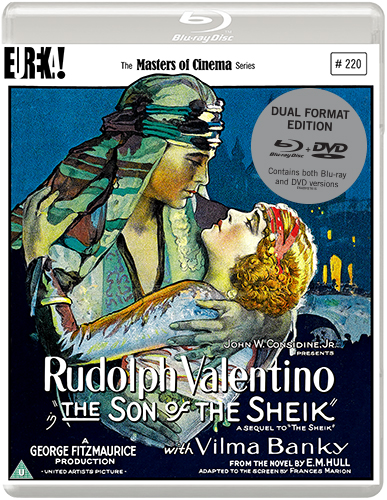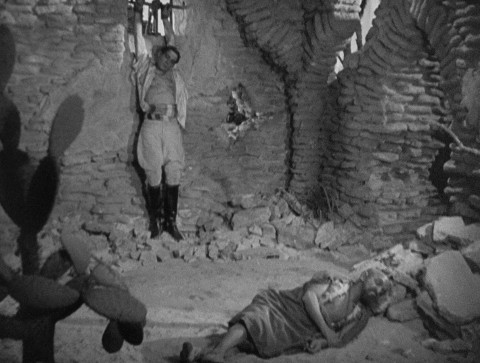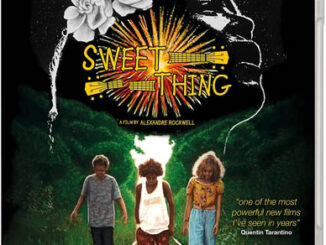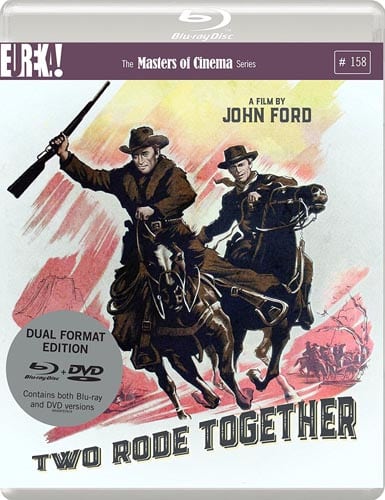The Son of the Sheik (1926)
Directed by: George Fitzmaurice
Written by: Edith Maude Hull, Frances Marion, Frédérique De Grésac, Paul Gerard Smith
Starring: George Fawcett, Montagu Love, Rudolph Valentino, Vilma Bánky
USA
AVAILABLE ON DUAL FORMAT BLU-RAY AND DVD: NOW, from EUREKA ENTERTAINMENT
RUNNING TIME: 69 mins
REVIEWED BY: Dr Lenera
Ahmed, son of Diana and Sheik Ahmed Ben Hassan, falls in love with Yasmin, a dancing girl who belongs to a troupe led by her father who are also thieves, and who is promised to the villainous Ghobah. In ruins near Touggourt, the city where Yasmin dances, she and Ahmed meet secretly until one night when her father and the gang capture the son of the sheik, torture him, and hold him for ransom. Ahmed is freed by friends, but now has vengeance on his mind, and decides to kidnap Yasmin….
I can’t imagine that many know of The Sheik and its sequel these days unless they really are dedicated movie buffs, but I reckon the name Rudolph Valentino is a bit more familiar, even if one isn’t sure where the name comes from. He was one of the first huge movie sex symbols, moviedom’s original ‘Latin Lover’, a term that was invented for Valentino by Hollywood moguls, who died at age 31. Eureka’s Blu-ray of the sequel to the film which introduced his defining role was my introduction to him, and I was immediately able understand why he was so popular; his charisma virtually leaps off the screen and I was also able to see why he made countless women weak at the knees. And my usual dislike of viewing a sequel to a film before I’d seen said precursor soon turned out to be unwarranted in this case, as it easily stands on its own, though I’m sure that fans of The Sheik loved seeing Valentino return to play the same character as he did in 1921 in addition to playing that character’s son, as well as have the pleasure of having Agnes Ayres also come back as the Sheik’s wife Diana. The film itself is a quick paced 69 minutes that certainly won’t drag for modern viewers, and it’s pretty cinematic too, though of course the melodrama is hugely dated, and I will say that I had a serious problem with one particular aspect of the story which left a truly bad taste in my mouth – and this is coming from someone who hates that religion called Political Correctness. But let’s leave that aside for a while.
By 1924, Valentino’s popularity had waned after two box office failures, Monsieur Beaucaire and A Sainted Devil, where he departed from his usual screen image. He also squabbled over money with Famous Players-Lasky, the studio he was signed to, which eventually led to him walking out on his contract. After he signed with United Artists in 1925, in an effort to capitalise on the success that Valentino had achieved with The Sheik, United Artists’ president Joseph M. Schenck bought the rights to Edith Maude Hull’s novel The Sons of the Sheik and cast Valentino in the dual role of father and son. The book was adapted for the screen by Frances Marion and Fred de Gresac, though they retained very little of it, and filming took place on location in California and in the Yuma Desert in Arizona. It opened at the Million Dollar Theater in Los Angeles and played for four weeks. However, while on a nationwide tour to promote the film, Valentino collapsed in his New York City hotel room and was rushed to the hospital. Doctors discovered he had a perforated ulcer which required emergency surgery. After the surgery, he developed peritonitis and died on August 23, 1926. The Son of the Sheik was put into general release nearly two weeks after Valentino’s death, and became a huge hit. A 1937 re-release censored certain scenes to conform to the then rigorously enforced Production Code. The film was one of over 200 titles in the list of films made available for television presentation by Advance Television Pictures announced in Motion Picture Herald 4 April 1942 when TV broadcasting was in its infancy.
One can not help but chuckle at the credits which include “turbulent music by”, though I was pleased to discover that this version uses the soundtrack by Carl Davis. Silent films can sometimes have the most irritating music scores, but Davis provided fine orchestral backing for lots of silent movies in the ‘80s and his Rimsky-Korsakov-influenced material here seems entirely appropriate except for maybe a few dramatic sequences where the music could have been more, well, “turbulent”. Anyway, a caption tells us that we’re “not east of Suez but south of Algiers”, hinting that this tale will be of an escapist, even fairy tale-like, nature. It’s of quite a light nature too – some cursory reading up on The Sheik indicated that it was a reasonably serious affair, but this one often seems to play up its absurdity in a knowing manner. “I’ll send your remains home. What’s your wife’s name”? “I don’t know her name, when I want her name I’ll whistle” is a typical exchange; it’s sexist but not to be taken seriously. Yasmin tells of falling for a mysterious rich stranger when she was dancing in the street. He offers her money but she tells him that the others will gamble it all away so he gives her a gold ring instead. This flashback is introduced nicely by her face dissolving into his, though this part of the story seems awfully rushed. We’re then told that love blossoms when the two periodically meet at these ruins, and in the next scene they do appear to be in love with all the usual emoting, though he refuses to admit that he’s the son of the Sheik. Yasmin’s companions including the jealous Ghobah capture Ahmed and, after telling him that Yasmin lured him to his doom, subject him to a slightly homoerotic scene where, tied up with his tailored white shirt torn to shreds, he’s whipped in the stomach. The Production Code that came in soon after would have forbidden the sight of the whip actually striking the chest, but here we’re able to view the event without enforced edits.
Ahmed is freed by others and, filled with hatred of Yasmin, kidnaps and rapes her, something of course not shown but clearly evident when he advances towards her with a bed in the background and she wakes up clearly having not had a good time. Seeing as Ahmed is a character we’re supposed to like even after the deed, this is a rather unpleasant addition. He doesn’t even seem to regret what he’s done very much, though at least she hates him for it – at least for a while. What’s interesting is not just that a woman wrote the novel but that another co-wrote the screenplay, so I guess one is supposed to take this as a female rape fantasy – which of course doesn’t mean that a woman wants to be raped in real life. But I couldn’t help but bristle and let this cast a shadow over the rest of the film, even though there was still quite a bit to enjoy. We wait for this couple to settle their differences and for Ahmed having to confront Yasmin’s gang again, leading to some pretty brisk riding about on horses even in a very well done sandstorm and some sword fighting with Valentino doing his inner Douglas Fairbanks [he even swings from a chandelier at one point], though the subplot of Yasmin’s betrothed disappears from the film, evidence perhaps of cutting. In any case, the emotional centre of the film turns out to really be Ahmed and his father. Perhaps it’s appropriate that in his final movie Valentino, sporting pretty good makeup [in fact if you didn’t know it I’m not sure that you’d recognise him], gets to play his only senior person and an older version of his signature role. The original character has now matured into a much wiser and nicer man, while his son is now the impetuous, self centred and brutal figure that he once wasn’t, though it’s probably best to ignore the implicatio that he initially raped the woman who became and still is his wife, something that gives the impression that sexual assault is just not regarded as a particularly bad thing in not just the world of these films but also the ‘20s.
It’s pretty cool seeing both Valentino characters join forces to fight the bad guys, especially seeing as for much of the time it’s surprisingly convincing. Yes, there are a few goofy shots where body parts merge, but to be honest this is probably to be expected in a film of this vintage. Other shots where the two of them are visible together would have still looked good thirty years later, and the concept is sold further by Valentino’s delivering of two very distinct performances, one good, one not so. While one can take his exaggerated emoting as the Sheik as being what was in fashion at the time, it’s odd that Valentino chose the older of his two roles within which to do this and be more restrained and naturalistic as Ahmed where it seems like, unlike many silent stars, he would have gone on to do very well in sound pictures. What’s even odder is that there seems to be a distinct sexual ambiguity about both his appearance and the way he’s photographed, often getting the soft close-ups that a female star would usually get. I wonder if this was partly because Valentino was the first big male star to be not American or English and therefor it was thought appropriate to treat him a bit differently, even accentuate any ‘differences’ he might have – which I guess leads me to other stuff which may rub some modern viewers up the wrong way, this film having been made at a time when an Arab character could be called Ramadan, non-white characters almost always played non-white characters [it possibly helps to know that the Sheik in the first film turned out to actually be white, though English – which Valentino certainly doesn’t look like whatsoever!] which was the norm for a great many decades to come, and other races were not exactly depicted with sensitivity.
Much of the humour concerns a very short fellow [just called Mounteback] who plays pranks on others and gets his in return, sometimes playing on his size. At one point he hides during a fight in a pot and somebody rolls it down some steps so it smashes. On another occasion he gets stabbed in the bum with a sword. I did chuckle on a few occasions. There’s a lovely bit where the sheik tries to put his rebellious son in his place by bending an iron bar; the son replies by straightening it out. It’s a deliberately silly, even campy, moment yet it also clearly establishes the strength of character and body of both men. The direction by George Fitzmaurice and the cinematography by the better known George Barnes are surprisingly fluid, especially seeing how heavy stuff tended to be back then. We forget that films in the ‘20s were often more cinematic than films in the ‘30s for a while because of how very early sound films required the performers to be right by sound recording equipment. Here, we get things like a nice panning shot revealing the presumably ‘loose ladies’ of an Arabic dive followed by a great pull back from Yasmin dancing on stage to show all the audience. The prelude to the rape has the camera zoom into both characters ending with a close-up of Yasmin’s eyes. Even some of the shots of the desert seem to have been thought through in terms of composition with some great employment of shadow, though after Valentino the best known name involved with this film is probably set designer William Cameron Menzies [Gone With The Wind, Things To Come], who constructs some reasonably authentic-looking Middle Eastern constructions. Indeed The Son Of The Sheik looks pretty good throughout and is a film which shouldn’t be hard for people not experienced in silent cinema to enjoy – well, as long as they can try to ignore its frankly disturbing sexual politics.
Rating: 









This was previously out on Blu-ray from Kino Lorber on Region A, but that release used a raggedy old print. Eureka use for their disc a new restoration by Modern VideoFilm/Cohen Media Group. The result is probably the best looking release of a silent picture I’ve so far seen. There’s remarkably little obvious print damage – obviously some extensive repair work was done because the Kino version was actually inaccurately framed to conceal edge flaws. The level of detail is quite considerable too. Very impressive.
As with Eureka’s Raining In The Mountain release which I reviewed yesterday, we get the always excellent David Cairns providing a highly informative video essay, Its 24 minutes are packed; you get Cairns reciting a Valentino-hating letter from the 1920’s published in ‘Photoplay’ magazine, information about Valentino [a figure I knew little about], commentary on the film with praise moderated by criticism of its sexual and racial elements, and barely concealed bafflement at a time in which women embraced a fantasy of male dominance – though linking it to certain recent E. L. James garbage seems to me to be a tad tenuous since the heroine in those stories is never actually raped nor is forced to do anything against her will. The essay replaces three short Valentino-centric shorts, two with behind the scenes Valentino footage, that were on the Kino, but Eureka have retained the Orson Welles intro from a TV series showcasing silent films, where the slightly bored-seeming legend discusses another legend, with lots of clips from Valentino movies.
The Son Of The Sheik isn’t a classic of cinema and is perhaps even more dated than you’d expect of a silent film, but it’s certainly an important movie in terms of pop culture and therefore ought to be seen by the true movie buff, if only to see what tickled people’s fancy in times gone by – oh, and to see what all the fuss concerning Valentino was about. Eureka’s release isn’t exactly extras-crammed but you’ll have never seen a silent film look this good. Recommended with Reservations.
SPECIAL FEATURES
*Presented in 1080p from a high-definition digital restoration, with a progressive encode on the DVD
*DTS-HD MA 5.1 and uncompressed 2.0 audio options on the Blu-ray
*Loitering Within Tent – A brand new video essay by David Cairns
*Introduction to the film by Orson Welles
*A collector’s booklet featuring a new essay by critic and film historian Pamela Hutchinson








Be the first to comment